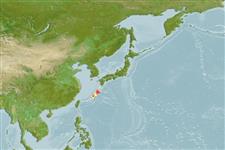Teleostei (teleosts) >
Tetraodontiformes (Puffers and filefishes) >
Tetraodontidae (Puffers) > Tetraodontinae
Etymology: Torquigener: Latin, torquere = to twist + Latin, generare = birth, race (Ref. 45335); albomaculosus: Named for the many white spots on the body.
Environment: milieu / climate zone / depth range / distribution range
Ecology
Marine; reef-associated; depth range 10 - 27 m (Ref. 97258). Tropical
Distribution
Countries | FAO areas | Ecosystems | Occurrences | Point map | Introductions | Faunafri
Northwest Pacific: Japan, Ryukyu Is.
Size / Weight / Age
Maturity: Lm ? range ? - ? cm
Max length : 12.0 cm TL male/unsexed; (Ref. 97259); 9.1 cm SL (female)
Short description
Identification keys | Morphology | Morphometrics
Dorsal soft rays (total): 9; Anal soft rays: 6; Vertebrae: 19. This species is distinguished by the following characters: D 9, A 6; pectoral-fin rays 16 with the dorsal-most ray nubbin-like and rudimentary; vertebrate 8 + 11 = 19; mid-side of body (from behind pectoral- to caudal-fin base) without the solid, dark, longitudinal stripe nor rows of dark spots; dorsal half of head and body with fine brown reticulations and many white spots, while ventral half silvery white with many white spots from chin to above anal-fin origin; dorsal rim of eye is light yellow; head and body with many two-rooted spinules (Ref. 97258).
This species has been observed by divers at 10-27 m on sandy bottom. Another population is found around 30 m at the northern part of Amami-oshima Island. Its behavior of building large geometric circles on sandy bottoms, makes this species unique. Female length (Ref. 97258). The circular structure plays an important role in influencing female mate choice, it functions to gather fine sand particles for constructing nests in preparaton for spawning (Ref. 97259).
Life cycle and mating behavior
Maturity | Reproduction | Spawning | Eggs | Fecundity | Larvae
Matsuura, K., 2015. A new pufferfish of the genus Torquigener that builds "mystery circles" on sandy bottoms in the Ryukyu Islands, Japan (Actinopterygii: Tetraodontiformes: Tetraodontidae). Ichthyol. Res. 62(2):207-212. (Ref. 97258)
IUCN Red List Status (Ref. 130435: Version 2024-1)
Threat to humans
Harmless
Human uses
Fisheries: of no interest
Tools
Special reports
Download XML
Internet sources
Estimates based on models
Phylogenetic diversity index (Ref.
82804): PD
50 = 0.5000 [Uniqueness, from 0.5 = low to 2.0 = high].
Bayesian length-weight: a=0.01622 (0.00726 - 0.03621), b=2.92 (2.74 - 3.10), in cm total length, based on LWR estimates for this (Sub)family-body shape (Ref.
93245).
Trophic level (Ref.
69278): 3.3 ±0.2 se; based on size and trophs of closest relatives
Resilience (Ref.
120179): High, minimum population doubling time less than 15 months (Preliminary K or Fecundity.).
Fishing Vulnerability (Ref.
59153): Low vulnerability (10 of 100).
